In 2008, Area 1 took on the planning and staging of the 2010 CNCH Weaving Conference to be held in Santa Clara . Fiber Artisans, a small (11 members) but active guild in area 1, took on the responsibility of supplying the gifts, in this case scarves, for the volunteers who would be working at the conference. Lotus Baker spearheaded the project and this is her tale.
Fiber Artisans took on the weaving of the Conference scarves not knowing that I would make it a challenge for us. It was a lot of work, but we learned a lot about dyeing, winding long warps, warping long warps, endless weaving and fringe twisting! We are proud of what we created!
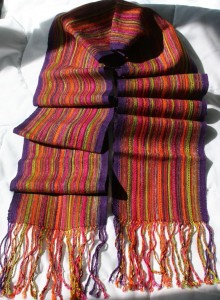
A finished scarf
Our First step was to find out the conference colors which turned out to be eggplant, orange, fuchsia and citron. After I talked with Nancy Weber, conference chairperson, about her ideas of what the scarves should look like, I remembered one of her comments was something about confetti. When I saw the Handwoven, November / December 2008, Sally Orgen’s “Divine Dimity goes Technicolor for Scarves”, I knew that was the one. I was looking for something that would be easy to weave and yet had stripes to be the confetti. I got Nancy’s approval and talked it up to the weavers. We talked about how many 8-shaft looms we had and which would be available to work on. There were 4 looms, we are a small group, and most of the looms had projects on them.
The Second step was to figure the yarn and dye needs for 32 (8 per loom) scarves, and where to get the best price. We put the weaving info into the computer program, Weave-it, to help with the calculating. Frank Mikulastik helped a lot with the math on his spreadsheet. We all used the computer printout for warping. The warp twill stripes in various widths were the four solid colors, which we changed from the original colors called for in Handwoven. The gold became orange, green became citron, adobe became fuchsia and spice brown became eggplant The background part of the design was plain weave warp of a variegated tencel yarn that moved from one color to the next and blended in with the solid color stripes. To order it pre-dyed in the right colors didn’t seem possible both in price and availability.
Fortunately there was another article in Handwoven in which Nancy Roberts and Penny Peters used a knitting machine to make a knit piece of fabric, known as a blank, and then dyed it to get a variegated yarn for weaving after unraveling the blank. Now I have a knitting machine, so we could make a knit blank. I ordered 10/2 white tencel yarn for the warp and a 20/2 eggplant cotton yarn for the weft from Halcyon in January 09 and picked up the Procion MX dye from Dharma in San Raphael in March 09.
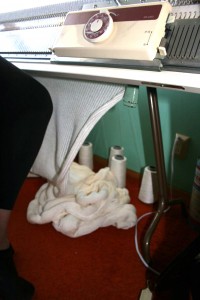
Knitting the blank
Dyeing, our Third step, took awhile! It wasn’t until August 09 that the pressure to get working started to get to us. We declared a dye day and 6 of us worked! I had decided that for the variegated yarn to be the same for each loom we should knit a blank with 4 strands as one thread and it needed to be a certain weight, which Frank calculated. So I set up the knitting machine and Marcia Kehr, Dee Dumont and myself took turns knitting until the piece weighed the the right amount.
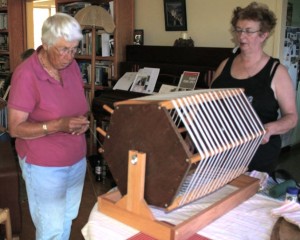
Phyllis Karsten and Dee Dumont winding warps to dye
In the meantime Phyllis Karsten, Frank and whoever wasn’t knitting were winding warps on warping reels for the solid color stripes. We wound the warp chains to the number of threads per stripe for the four looms.
Kimberly Louie became the Dye Master and set up the dye station outside on the deck.. The knit blank was treated with soda ash then laid out on the deck on a long piece of plastic. We started to sponge stick (made from chopsticks and kitchen sponges) the dye in diagonals down the length of this piece that was about 23 feet long and 15 to 16 inch wide. It took one and a half hours from one end to the other! Then we covered it and rolled it up into one big burrito! The stripe colors were easy: treat with soda ash and put into a bucket of color for the right amount of time, pull out the warp, wrap up in plastic to set the color. From start to clean up, 10 hours later, the dyeing was done. Well almost, we had to dye a bit more another day, but that was easy in comparison.
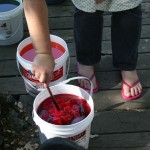
Dyeing solid colors
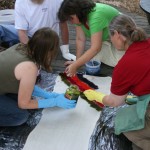
Beginning the dyeing of the blank
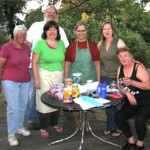
The Crew:Phyllis Karsten,Frank Mikulastik, Kimberly Louie, Lotus Baker, Marcia Kehr, Dee Dumont
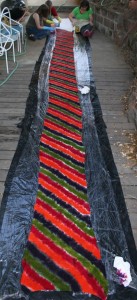
The dyeing completed on the knitted blank
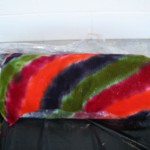
The" Giant Buritto"
Fourth step was getting the different colors divided out for the four looms . The solid colors were pretty easy, as we had wound the warp chains to threads per stripe. I put warp chains in plastic grocery bags with the end of the chain looped around the handle (Frank’s way of keeping the chains tidy). The now variegated knit blank was a problem. After rinsing it, I then unraveled it out on my warping reel so that it would dry smooth. However, to separate the four strands involved the need for four yarn winders and four hands -which I didn’t have!
With patience and invention they got separated. Here is where I goofed and didn’t measure the guide string. I used one that had been used on some of the solid stripes which was the wrong length. All the variegated was measured too long and so we had to rethink the color sequence between stripes. Bet you didn’t notice!
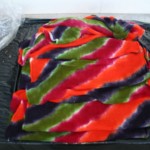
The dyed blank waiting to be unravelled
Phyllis, Sharolene Brunston, and Marcia wound 20/2 cotton eggplant colored weft yarn onto sectional bobbins or small spools for us on another day. This was a great way to share one cone of yarn with a number of people.
The Fifth step was getting the warps and weft to the weavers and for them to find the time to get the project on the loom. Jean Shoe got her warp on the loom first in October 09, so she was the one to find problems and sample. Over the next couple of months she and Frank wove 7 scarves. From January through early February, the rest of us started and we were neck to neck to the finish. Kimberly wove 7 scarves, and Marcia wove 7 scarves, and myself, 9 scarves, for a total of 30 scarves. We had more than enough for the conference committee heads and others.
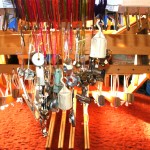
Tension problems? Solved!
We all had problems with warp tension. None of had woven with tencel before and most of us had never put on an almost 20 yard warp. It really needed a tight tension, the yarn had “fuzzies” from the chain ties and a number of other problems depending on whose loom it was on and how they had threaded the loom.
Because of the wrong guide string in the winding stage, we had long chains of the orange and the variegated. These and about one scarf’s worth of thrums from 3 looms were used by Jean for the Glenna Harris guild project of making neck strings for the name tags. I did an eighth and ninth because my thrums were not needed and because I could. I wove the ninth scarf with a fuchsia 20/2 cotton weft to be given the the guest speaker.
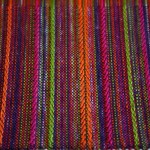
Close up of the weaving
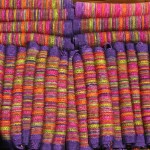
Scarves finished and ready for Conference
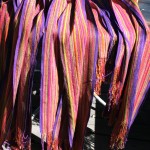
Woven scarves waiting for the finishing touches
Step Six was twisting the fringes. We did it on our March meeting day : we sat, visited and twisted! We recommend fringe twisters: fine threads and lots of scarves equal a twister! Elaine Hill, Sandy Kupper and others of us did have to twist fringes at home to get them done.
Seventh and final step was washing, pressing and labeling the scarves. The labels were a good idea that I had to help the recipients remember the why and when of the occasion. Thank goodness for a neighbor with an embroidery machine!
We finished on April 7 with two days to go to the start of the conference, which was April 9, 2010. Lots of time to spare!
The most fun of the whole project was to see the scarves being worn with pride and style at the conference and since then! Even people who thought the colors were awful, most of us who wove them, decided they looked South American and we liked them! Or, as one of us, who was also on the conference committee, said,” I don’t think I really appreciated it or really looked at it until it was off the loom and I tried to explain what we had done to someone who had nothing to do with the project and wasn’t a weaver. It was then that I really looked at it –and I’m keeping my scarf.”
I hope this article made you eager for our next conference. Click for more Sewing tales!